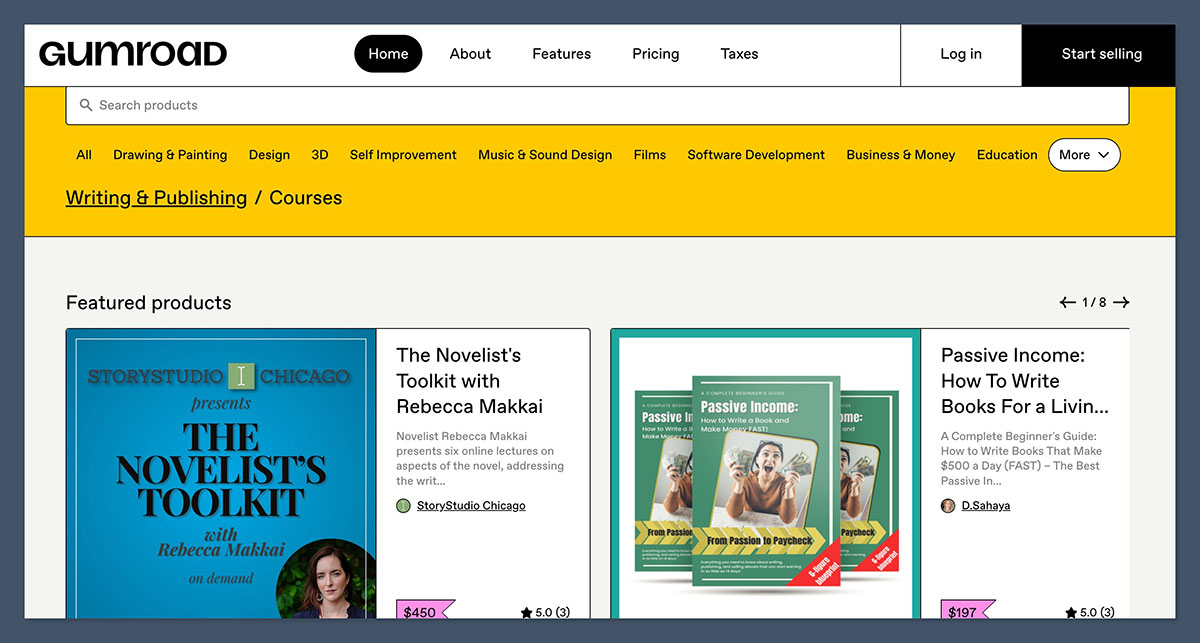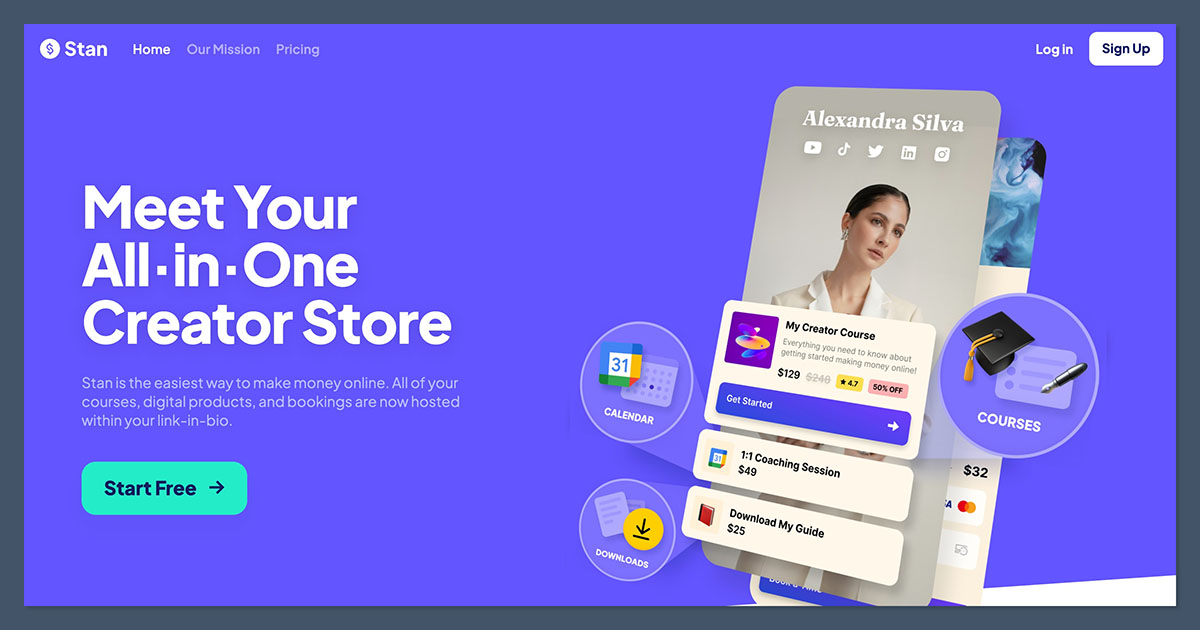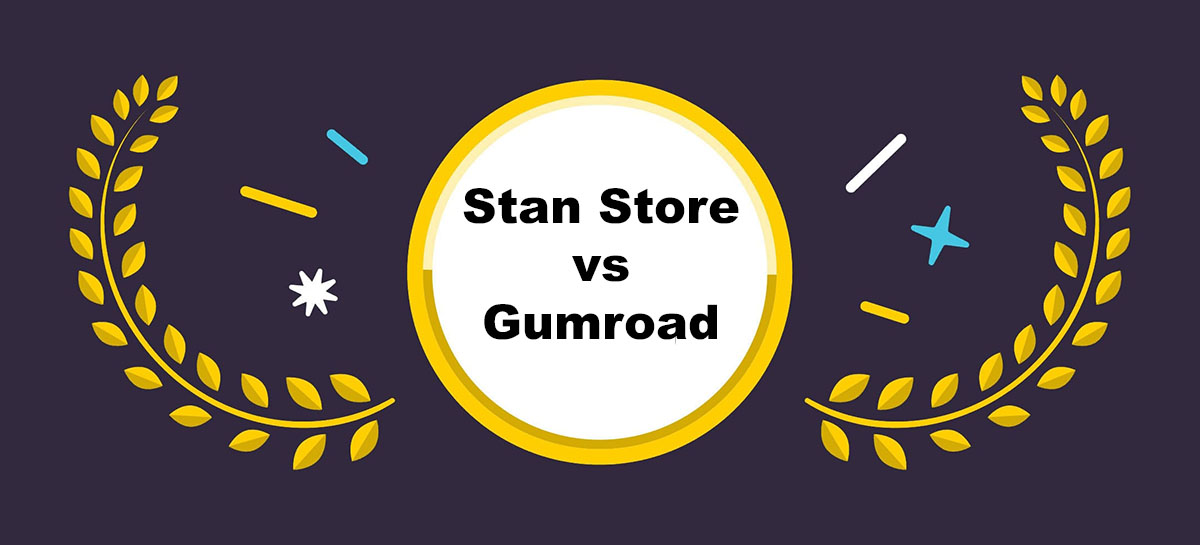If you’re selling print on demand products and can’t decide between Gumroad and Stan Store, here’s the quick answer:
Stan Store is better for influencers and social-first sellers who want fast, mobile-first product pages.
Gumroad is better for indie creators who want flexibility, better customer control, and built-in discovery.
I’ve spent 10+ years selling online — shirts, mugs, posters, you name it. I’ve tried both platforms with POD products, and here’s how they stack up.
Quick Comparison: Gumroad vs Stan Store
| Feature | Gumroad | Stan Store |
|---|---|---|
| Best for | Indie creators, flexible sellers | Influencers, mobile-first sellers |
| Print on Demand Support | Manual or Zapier-based | Manual or Linktree-style delivery |
| Pricing | Free to start + 10% fee | $29–$99/month (flat) |
| Checkout | Simple, frictionless | Mobile-first, basic options |
| Audience Data Access | Full data export | Basic analytics only |
| Custom Domains | Yes | No |
| Integrations | Zapier, email, affiliates | Limited |
| Design Control | Minimal | Minimal |
What Most People Get Wrong
Here’s the truth — both of these platforms look simple, but they serve totally different types of sellers.
Most new creators assume that because both tools help you sell digital products, they’re interchangeable. They’re not.
If you pick the wrong one, you’ll either hit limits too soon or overpay for stuff you don’t need.
Let’s break it down:
Gumroad is built for long-term creators who:
- Want to own their customer list
- Need more control over pricing, emails, and delivery
- Prefer a low-risk model with no monthly fees
- Might test and sell multiple product types over time
Stan Store is built for creators who:
- Monetize directly from Instagram, TikTok, or YouTube
- Don’t want to deal with integrations or automations
- Just need a clean, simple link-in-bio storefront
- Sell a small set of offers (like ebooks or coaching)
Here’s a quick comparison:
| Use Case | Better Platform |
|---|---|
| Email list building | Gumroad |
| Mobile sales via social | Stan Store |
| Complex POD fulfillment | Gumroad |
| Fast setup for digital offers | Stan Store |
| Long-term product scaling | Gumroad |
If you’re deep into print on demand and care about fulfillment workflows, email marketing, and customer data — you’ll outgrow Stan Store fast.
You’ll start hitting walls when trying to automate, collect leads, or manage multiple offers. It’s not built for backend complexity.
Stan Store works best when you treat it like a checkout page, not a full business hub.
Verdict:
If you’re in this game for long-term brand-building, Gumroad is more aligned with your goals.
Stan Store is great for quick link monetization and fast launches, but not ideal for scaling or automation-heavy setups.
Pricing: Flat Fee vs Rev Share
Pricing is where a lot of creators trip up — especially if you’re just getting started with print on demand. The wrong pricing model can bleed cash or limit your growth, depending on your stage and volume.
Let’s start with Gumroad:
- It’s free to sign up.
- They take 10% per transaction, plus payment processor fees (usually around 2.9% + $0.30 via Stripe or PayPal).
Optional Gumroad Pro plan at $10/month gives access to:
- Custom branding (CSS + design tweaks)
- Advanced analytics
- Email tools and segmentation
- Priority support
Now compare that to Stan Store:
- Starts at $29/month for the Creator plan
- Jumps to $99/month for the Creator Pro tier
- No per-sale transaction fees — what you make is yours
Features vary by plan, with the Pro tier offering:
- Booking calendar
- Funnel builder
- Multiple product types (digital, coaching, bundles)
The pricing models are totally different. Here’s how they compare at a glance:
| Platform | Monthly Fee | Transaction Fee | Total Cost Example (on $1,000 sales/month) |
|---|---|---|---|
| Gumroad (Free) | $0 | 10% + ~3% | ~$130/month |
| Gumroad Pro | $10 | 10% + ~3% | ~$140/month |
| Stan Store | $29 | 0% | $29/month |
| Stan Pro | $99 | 0% | $99/month |
Now let’s make this even simpler:
- Gumroad takes more when you sell — good for low-volume or testing products
- Stan takes more no matter what — better if you’re generating consistent sales
One mistake I see is creators jumping into Stan too early. That monthly cost adds up if your audience isn’t converting, especially with POD margins.
Verdict:
If you’re selling higher volumes consistently, Stan Store might work out cheaper long-term.
But if you’re just starting out, testing offers, or have inconsistent traffic, Gumroad’s pay-as-you-sell model is safer and easier on your cash flow.
Selling POD Products on Each Platform
If you’re running a print on demand business, fulfillment matters.
Unlike Shopify or Etsy, neither Gumroad nor Stan Store offers direct integration with print-on-demand providers like Printful, Gelato, or Printify.
But that doesn’t mean it’s impossible — it just means you’ll need some workarounds.
How Gumroad Handles POD
Gumroad is more flexible by nature. It was designed for digital product delivery, but clever POD sellers have found ways to make it work:
- Sell a “digital” product that acts as a trigger for order fulfillment (like a PDF receipt or form)
- Use Zapier to connect Gumroad to Printful, Gelato, or any other POD platform
- Deliver custom PDFs or order forms with customer details that kick off fulfillment workflows
- Accept custom order fields to collect sizing, colours, or personalization info
This setup takes some initial effort, but it scales and automates better than most expect.
How Stan Store Handles POD
Stan Store is much more lightweight — it wasn’t built for POD sellers, but for influencers selling info products, coaching, or services. Still, there are a few manual workarounds:
- Link out to your POD store (Shopify, Etsy, Spreadshirt, etc.)
- Sell a “digital download” that notifies you to fulfill the order manually
- Use it more like a sales funnel or checkout layer than a backend system
There’s no Zapier, no API access, and no structured way to collect detailed order info unless you use external tools.
Here’s a side-by-side of the core differences:
| Feature | Gumroad | Stan Store |
|---|---|---|
| Native POD Integration | No | No |
| Zapier/Automation Support | Yes | No |
| Link to External POD Store | Yes | Yes |
| Custom Order Fields | Yes (via Gumroad Pro or scripts) | No |
| Works as POD Trigger System | Yes | Manual Only |
Verdict:
Gumroad is more customizable and scalable for POD sellers who want to automate fulfillment and keep control of the process.
Stan Store works better if you just want to sell fast and don’t mind handling everything manually in the backend. If you’re serious about growing a POD brand, Gumroad gives you more room to build solid systems.
Checkout Experience and Payment Processors
The checkout flow can make or break your conversion rate — especially in print on demand, where margins are thin and abandoned carts are common.
Each platform takes a different approach here, and that can have a big impact on your customer’s experience.
Gumroad

Gumroad keeps things simple, but still gives you a decent amount of control. Here’s what it supports:
- Accepts credit cards and PayPal — this makes it accessible to a broader global customer base
- Customers stay on your domain during the checkout process (or on Gumroad’s minimal branded page, if you don’t use a custom domain)
- Global-friendly — available in most countries and supports multiple currencies
- Fast payouts — every Friday, straight to your bank or PayPal, depending on your setup
Gumroad’s checkout is frictionless, with minimal steps, and it works well across desktop and mobile.
Stan Store

Stan Store is even more stripped down — built for speed and mobile-first users:
- Credit cards only — PayPal is not supported
- Customers are redirected to a mobile-first checkout page (designed for link-in-bio clicks)
- Payouts depend on your Stripe account, including payout schedule and bank transfer timing
- No customization — you can’t add custom fields, upsells, or dynamic pricing
It’s ideal if you want to sell a fixed offer quickly, but not if you need control over the experience.
Here’s a direct comparison:
| Feature | Gumroad | Stan Store |
|---|---|---|
| Accepts PayPal | Yes | No |
| Accepts Credit Cards | Yes | Yes |
| Mobile Checkout | Yes | Yes (mobile-first) |
| Checkout on Custom Domain | Yes (Pro plan) | No |
| Custom Fields / Upsells | Limited (via scripts/Zapier) | No |
| Payout Speed | Weekly via Gumroad | Based on Stripe account |
| Multi-Currency Support | Yes | Limited |
Verdict:
Gumroad has a smoother, more robust checkout process — especially if you need PayPal, global payments, or more control.
Stan Store keeps it basic, which works for quick sales but not for sellers who rely on international reach or detailed workflows.
Audience Ownership and Data Access
This is where the gap between Gumroad and Stan Store really shows — and for print on demand sellers who rely on email, retention, and segmentation, it’s a deal-breaker.
Your audience isn’t just a list — it’s your entire business. Being able to access, manage, and market to your buyers after the first sale is what drives long-term profit.
Gumroad
Gumroad gives you full control over your audience data. You can:
- View and export full customer info, including names, emails, product history, and purchase value
- Export CSVs any time to migrate into your email platform or CRM
- Run built-in email campaigns or tag customers for segmentation (Gumroad Pro)
- Connect to platforms like ConvertKit or MailerLite via integrations or Zapier
- Use customer tags to send different messages based on behavior or product type
This means you can actually build a real backend for your business — email flows, cross-sells, launch campaigns — all tied to real buyer activity.
Stan Store
Stan keeps it extremely simple. You get:
- Basic dashboard analytics — views, clicks, and sales
- Very limited customer data — often just the email and amount paid
- No tagging, no segmentation, and no email campaigns
- If you want to email your customers, you’ll have to pull their info manually and use a separate platform
You’re basically renting the audience, not owning it.
Here’s how they stack up:
| Feature | Gumroad | Stan Store |
|---|---|---|
| Customer Email Access | Full | Limited |
| Order History / Purchase Details | Yes | Basic (single-order view) |
| Data Export (CSV) | Yes | No native export |
| Built-in Email Marketing | Yes (with Pro) | No |
| Segmentation / Tagging | Yes | No |
| Integrations with Email Tools | Yes (via Zapier) | No |
Verdict:
If email is your POD superpower (and it should be), Gumroad gives you the keys. You get the data, the tools, and the freedom to build backend systems that grow your revenue.
Stan Store locks the door — it’s built for selling, not for building long-term customer relationships.
Apps, Automation, and Integrations
For most serious POD sellers, integrations and automations aren’t optional — they’re what keep your store running without constant hand-holding.
Whether it’s syncing orders, tagging leads, or managing email flows, your tech stack needs to talk to each other.
This is where the divide between Gumroad and Stan Store becomes even clearer.
Gumroad
Gumroad offers just enough flexibility to build a lightweight system behind the scenes.
It’s not as robust as a full eCommerce platform like Shopify, but it plays well with tools most creators use. You can:
- Connect to Zapier, which opens up workflows with thousands of apps (Printful, Google Sheets, Airtable, ConvertKit, and more)
- Integrate with email platforms like ConvertKit, MailerLite, or ActiveCampaign
- Set up custom automation rules for tagging, follow-ups, and product access
- Run affiliate programs right out of the box (without third-party software)
- Push buyer info into other systems for fulfillment or CRM tracking
This makes Gumroad a strong middle ground — simple upfront, but expandable on the backend if you know what you’re doing.
Stan Store
Stan Store keeps things locked down by design. It’s meant to be plug-and-play, and that comes at a cost:
- No Zapier or API support
- No third-party app marketplace
- Only basic integrations with Stripe and Calendly (mostly for coaching and services)
- No webhook access, which limits automation with fulfillment tools or CRMs
- Designed for creators who don’t want to mess with settings or workflows
For some, this “closed garden” approach works — fewer decisions, faster setup. But if you’re building a POD system with email, fulfillment, and segmentation, you’ll hit limits fast.
Here’s a direct comparison:
| Feature | Gumroad | Stan Store |
|---|---|---|
| Zapier Support | Yes | No |
| Email Marketing Integrations | Yes (via Zapier/API) | No |
| Affiliate Program Support | Built-in | No |
| POD Fulfillment Automation | Yes (via Zapier) | Manual only |
| API or Webhooks | No direct API, Zapier covers most | No |
| App Marketplace | No | No |
Verdict:
Gumroad gives power users room to grow — it connects with the tools most POD sellers use and supports automation that saves hours of manual work.
Stan Store keeps it simple — too simple for sellers who rely on systems, integrations, or any kind of operational backend. It’s better suited for solo creators with one offer and no tech stack.
Support and Stability
When your storefront goes down or you run into a technical issue with orders, support matters. Especially if you’re running paid traffic or relying on automation.
This is one area where the experience behind each platform starts to show.
Gumroad
Gumroad’s support is minimalist, and sometimes frustrating. It’s available, but not always fast or thorough.
- Email-only support — no live chat or ticketing system
- The team has a reputation for being slow to respond or silent on bigger updates
- Limited help documentation compared to larger platforms
- The platform has seen some ups and downs over the years — including layoffs, internal changes, and periods of reduced product development
Despite this, it still runs reliably and hasn’t disappeared. It’s lightweight, and for many creators, it just works — as long as you don’t need a lot of handholding.
Stan Store
Stan is newer, but leans into more modern support channels. It’s clearly designed for creators who want faster answers.
- Responsive via email and live chat, especially during business hours
- Strong social media presence — they actively support users on platforms like Twitter, Instagram, and TikTok
- Includes some basic help docs and onboarding tutorials
- The company is VC-backed, meaning faster growth, but also less predictability long-term
The support experience feels more hands-on and creator-friendly, but the platform is still young. That means updates can roll out fast — sometimes without much notice.
Here’s how they stack up:
| Feature | Gumroad | Stan Store |
|---|---|---|
| Email Support | Yes | Yes |
| Live Chat | No | Yes |
| Help Documentation | Basic | Basic |
| Community / Social Support | Minimal | Active |
| Company Age | Founded in 2011 | Founded in 2021 |
| Stability Track Record | Proven, but lean team | Still building, fast-moving |
| Backing | Independent | Venture Capital funded |
Verdict:
Stan Store has better day-to-day support — fast replies, friendly team, and modern communication channels.
Gumroad has been around longer, with fewer moving parts, but offers less active support. If you want stability and simplicity, Gumroad wins. If you want guidance and interaction, Stan delivers more hands-on help.
My Final Verdict
After working in print on demand for over a decade, I’ve tested just about every platform out there. And while both Gumroad and Stan Store have their place, they’re not built for the same kind of seller.
If you’re serious about building a long-term POD brand, collecting customer data, and automating backend systems — you need more than just a payment page. You need ownership, flexibility, and tools that scale with your business.
Choose Gumroad if you want:
- Control over pricing, data, and delivery
- Automation using Zapier, email flows, and order triggers
- Email ownership and the ability to build real backend campaigns
- Flexibility to test products, change offers, and scale workflows
Choose Stan Store if you want:
- Fast link selling with a mobile-first checkout
- A clean bio link setup for social monetization
- Quick digital delivery for simple files, templates, or booking links
- No backend complexity, just a direct sales page
Here’s a quick summary:
| Best For… | Choose Gumroad | Choose Stan Store |
|---|---|---|
| Building a full POD brand | Yes | No |
| Fast setup for one product | No | Yes |
| Email list and segmentation | Yes | No |
| Fulfillment automation | Yes | No |
| Social-first, link-in-bio selling | No | Yes |
| Growing your backend systems | Yes | No |
Personally, I use Gumroad for my print on demand sales. It lets me build workflows with Printful, segment and email my buyers, and keep full control of my data.
I can experiment, scale, and still know that everything is mine — the customers, the delivery, the experience.
If you’re just starting out with a single offer and want something clean and quick, Stan Store might work.
But if you’re building a real business behind your products, Gumroad is the better long-term tool.






